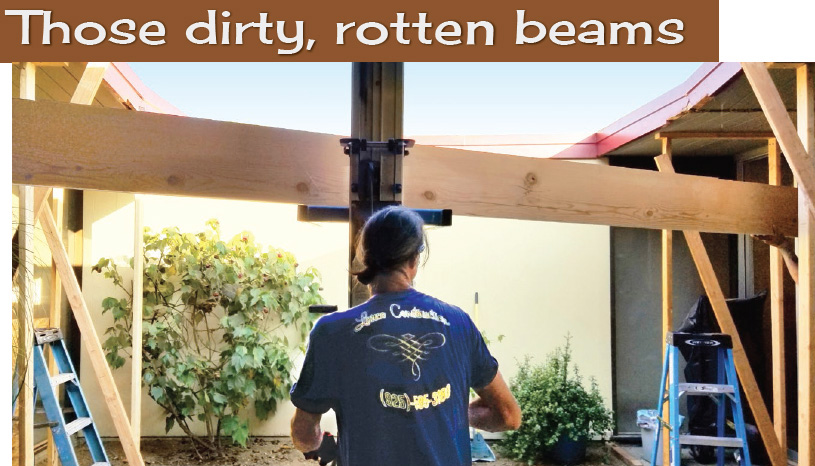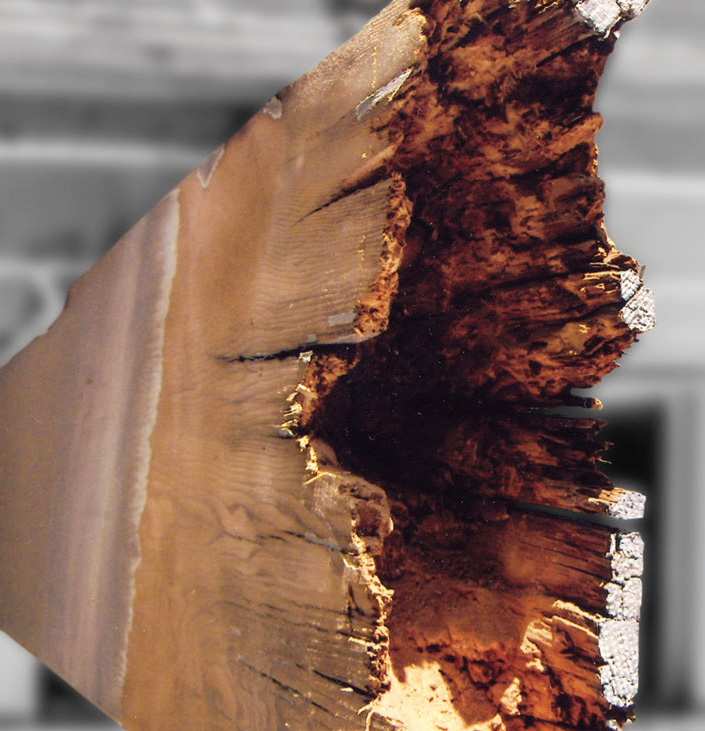Those Dirty, Rotten Beams
 |
|
|
You gaze up at their simple beauty every day—yet never actually see what’s rotten lurking right before your eyes: dry rot and water damage!
The architecture of mid-century modern makes it easy for your home’s exterior horizontal beams to get exposed to the elements. The beams project out to or beyond the roof-edge framing, and their degree of vulnerability depends on the home’s orientation to the sun and its amount of exposure to rough weather, and how well the beams are maintained.
A lack of regular maintenance guarantees deterioration over time. Eichlers are impacted mostly in outside atriums and carports, while Streng homes are hit in their overhangs. Decades of exposure wear away paint, leaving beams open to cracking, dry rot, and termites.
“Those beams get beat up, getting exposed to the sun, the wind, and the rain,” says Frank Larson, the now-retired founder of Larco Construction Services, who’s worked on Eichler beams with son, Tyler, in the East Bay for more than 25 years. “With a 60-year-old house, this is not a new problem—you are just now noticing it.”
Dry rot is the weakening of wood caused by fungus, which digests the parts of the wood that give it strength and rigidity. It all starts with excessive moisture. Moisture can attract termites, which can eat and destroy a beam quickly, breaking down its structural integrity.
 |
|
|
“We first identified the problem 20 years ago,” recalls Lee, who was put off by over the years contractors who considered the project “too small.” “But we saw the problem mounting over time, with the roof sagging, and rot and decay increasing. We were getting desperate.”
Then she found Eichler specialists Larco Construction Services. “They came in and did the job right,” she says. “They replaced the beam from post to post—and there was no jerry-rigging by cutting out a section and patching with an insert.”
When beams rot, you have two possible maintenance options: repair or replace. For Oakland Eichler owner Paula Lee, her rotting atrium beam meant finding an experienced and willing contractor to orchestrate a replacement.
Telltale signs
Sometimes beam damage is obvious, and other times it can take a considerable amount of detective work, because layers of fillers and paints can mask the damage. If you haven’t maintained or inspected your beams in a while, it may be time to call in a licensed contractor. But before taking that step, there are telltale signs pointing to damage that you should look for yourself.
On Strengs, the calling cards for damaged overhanging beams are crumbling or warped beam-ends—both signs of advanced decay. Peeling paint, caulking that has separated from the wood, and the presence of mildew or fungus can also indicate moisture problems.
 |
On Eichler beams, check for wood that is pushing downward, and for beam undersides that balloon out. When a beam looks like it coves in, it could be a sign of dry rot or termites.
“Dry rot is a slow-developing issue, and people can get immune to it,” Larson says. When you see a crack or an indentation, they are warning signs that issues are developing. You have to get in there, Larson says, “and clean it out to see how deep the erosion is.”
“You can get up there, and take something sharp, and poke it,” says Joe Gomes, owner of Joe Gomes Construction, which specializes in Sacramento-area Streng homes. “If the wood looks like it’s sucked in, then there is rot on the inside, and there is probably water leaking into it from the top.”




